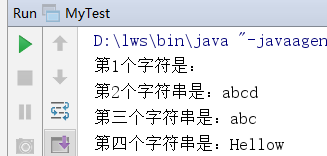String类、字符串构造方法、==、equals和equalsIgnoreCase方法、length、concat、charAt、indexOf、字符串截取、分割、替换、统计字符串字符出现次数
目录
String类
字符串特点(重点)
String类构造方法
列:使用多种方式实现创建字符串
字符串==符号的用法
列:字符串==符号的使用
equals用法与equalsIgnoreCase用法
列:练习使用equals和equalsIgnoreCase
字符串常用方法
length()、concat()、charAt()、indexOf()
列:字符串length()、concat()、charAt()、indexOf()方法练习
字符串的截取方法substring()
字符串转化成字符数组toCharArray()
字符串转化成字节数组getBytes()
字符串内容替换replace()
字符串分割split()
列:字符串拼接练习
列:统计一个字符串中各种字符出现的次数
String类
java.lang.String 类代表字符串。类代表字符串。
字符串特点(重点)
1. 字符串的内容永不可变。【重点】
2. 正是因为字符串不可改变,所以字符串是可以共享使用的。
3. 字符串效果上相当于是char[]字符数组,但是底层原理是byte[]字节数组。
String类构造方法
三种构造方法:
- public String():创建一个空白字符串,不含有任何内容。
- public String(char[] array):根据字符数组的内容,来创建对应的字符串。
- public String(byte[] array):根据字节数组的内容,来创建对应的字符串。
列:使用多种方式实现创建字符串
public static void main(){
//空参构建
String str1=new String();
System.out.println("第1个字符是:"+str1);
//字符数组构建字符串
char[] charArray={'a','b','c','d'};
String str2=new String(charArray);
System.out.println("第2个字符串是:"+str2);
//字节数组创建字符串
byte[] byteArray={97,98,99};
String str3=new String(byteArray);
System.out.println("第三个字符串是:"+str3);
//直接创建字符串
String str4="Hellow";
System.out.println("第四个字符串是:"+str4);
}结果:
字符串==符号的用法
字符串常量池:程序当中直接写上的双引号字符串,就在字符串常量池中。
- 对于基本类型来说,==是进行数值的比较。
- 对于引用类型来说,==是进行【地址值】的比较。
列:字符串==符号的使用
public static void main(String[] args) {
String str1 = "abc";
String str2 = "abc";
char[] charArray = {'a', 'b', 'c'};
String str3 = new String(charArray);
System.out.println(str1 == str2); // true
System.out.println(str1 == str3); // false
System.out.println(str2 == str3); // false
}equals用法与equalsIgnoreCase用法
- ==符号是两个数值地址进行比较
- equals是连个数值内容进行比较
equals使用注意事项:
1. 任何对象都能用Object进行接收。
2. equals方法具有对称性,也就是a.equals(b)和b.equals(a)效果一样。
3. 如果比较双方一个常量一个变量,推荐把常量字符串写在前面。
推荐:"abc".equals(str) 不推荐:str.equals("abc")
public boolean equalsIgnoreCase(String str):忽略大小写,进行内容比较。
列:练习使用equals和equalsIgnoreCase
public static void main(String[] args) {
String str1 = "Hello";
String str2 = "Hello";
char[] charArray = {'H', 'e', 'l', 'l', 'o'};
String str3 = new String(charArray);
System.out.println(str1.equals(str2)); // true
System.out.println(str2.equals(str3)); // true
System.out.println(str3.equals("Hello")); // true
System.out.println("Hello".equals(str1)); // true
String str4 = "hello";
System.out.println(str1.equals(str4)); // false
System.out.println("=================");
String str5 = null;
System.out.println("abc".equals(str5)); // 推荐:false
// System.out.println(str5.equals("abc")); // 不推荐:报错,空指针异常NullPointerException
System.out.println("=================");
String strA = "Java";
String strB = "java";
System.out.println(strA.equals(strB)); // false,严格区分大小写
System.out.println(strA.equalsIgnoreCase(strB)); // true,忽略大小写
// 注意,只有英文字母区分大小写,其他都不区分大小写
System.out.println("abc一123".equalsIgnoreCase("abc壹123")); // false
}字符串常用方法
length()、concat()、charAt()、indexOf()
- public int length():获取字符串当中含有的字符个数,拿到字符串长度。
- public String concat(String str):将当前字符串和参数字符串拼接成为返回值新的字符串。
- public char charAt(int index):获取指定索引位置的单个字符。(索引从0开始。)
- public int indexOf(String str):查找参数字符串在本字符串当中首次出现的索引位置,如果没有返回-1值。
列:字符串length()、concat()、charAt()、indexOf()方法练习
public static void main(String[] args) {
// 获取字符串的长度
int length = "asdasfeutrvauevbueyvb".length();
System.out.println("字符串的长度是:" + length);
// 拼接字符串
String str1 = "Hello";
String str2 = "World";
String str3 = str1.concat(str2);
System.out.println(str3); // HelloWorld,新的字符串
// 获取指定索引位置的单个字符
char ch = "Hello".charAt(1);
System.out.println("在1号索引位置的字符是:" + ch);//e
System.out.println("==============");
// 查找参数字符串在本来字符串当中出现的第一次索引位置 ,索引从0开始
// 如果根本没有,返回-1值
String original = "HelloWorldHelloWorld";
int index = original.indexOf("llo");
System.out.println("第一次索引值是:" + index); // 2
System.out.println("HelloWorld".indexOf("abc")); // -1
}字符串的截取方法substring()
public String substring(int index):截取从参数位置一直到字符串末尾,返回新字符串。
public String substring(int begin, int end):截取从begin开始,一直到end结束,中间的字符串。
备注:[begin,end),包含左边,不包含右边。
String str1 = "HelloWorld";
String str2 = str1.substring(5);
System.out.println(str2); // World,新字符串
String str3 = str1.substring(4, 7);
System.out.println(str3); // oWo字符串转化成字符数组toCharArray()
public char[] toCharArray():将当前字符串拆分成为字符数组作为返回值。
Char[] a="Hello".toCharArray();
System.out.println("字符数组第一个2个数:"+a[1]+"字符数组长度"+a.length);//e 5
字符串转化成字节数组getBytes()
public byte[] getBytes():获得当前字符串底层的字节数组。
// 转换成为字节数组
byte[] bytes = "abc".getBytes();
for (int i = 0; i < bytes.length; i++) {
System.out.println(bytes[i]); //97 98 99
}
System.out.println("==============");字符串内容替换replace()
public String replace(CharSequence oldString, CharSequence newString): 将所有出现的老字符串替换成为新的字符串,返回替换之后的结果新字符串。 备注:CharSequence意思就是说可以接受字符串类型。
String str1 = "How do you do?";
String str2 = str1.replace("o", "*");
System.out.println(str2); // H*w d* y*u d*?字符串分割split()
public String[] split(String regex):按照参数的规则,将字符串切分成为若干部分。
注意事项:
split方法的参数其实是一个“正则表达式”。
注意:如果按照英文句点“.”进行切分,必须写"\\."(两个反斜杠)
String str1 = "aaa,bbb,ccc";
String[] array1 = str1.split(",");
for (int i = 0; i < array1.length; i++) {
System.out.println(array1[i]);
}
System.out.println("===============");
String str2 = "aaa bbb ccc";
String[] array2 = str2.split(" ");
for (int i = 0; i < array2.length; i++) {
System.out.println(array2[i]);
}
System.out.println("===============");
String str3 = "XXX.YYY.ZZZ";
String[] array3 = str3.split("\\.");
System.out.println(array3.length); // 0
for (int i = 0; i < array3.length; i++) {
System.out.println(array3[i]);
}列:字符串拼接练习
定义一个方法,把数组{1,2,3}按照指定格式拼接成一个字符串。格式参照如下:[word1#word2#word3]。
public static void main(String[] args) {
int[] array = {1, 2, 3, 4};
String result = fromArrayToString(array);
System.out.println(result);
}
public static String fromArrayToString(int[] array) {
String str = "[";
for (int i = 0; i < array.length; i++) {
if (i == array.length - 1) {
str += "word" + array[i] + "]";
} else {
str += "word" + array[i] + "#";
}
}
return str;
}列:统计一个字符串中各种字符出现的次数
public class Demo07StringCount {
static int countUpper = 0; // 大写字母
static int countLower = 0; // 小写字母
static int countNumber = 0; // 数字
static int countOther = 0; // 其他字符
public static void main(String[] args) {
Scanner sc = new Scanner(System.in);
System.out.println("请输入一个字符串:");
String input = sc.next(); // 获取键盘输入的一个字符串
char[] charArray = input.toCharArray();
for (int i = 0; i < charArray.length; i++) {
char ch = charArray[i]; // 当前单个字符
if ('A' <= ch && ch <= 'Z') {
countUpper++;
} else if ('a' <= ch && ch <= 'z') {
countLower++;
} else if ('0' <= ch && ch <= '9') {
countNumber++;
} else {
countOther++;
}
}
System.out.println("大写字母有:" + countUpper + "小写字母有:" + countLower);
System.out.println("数字有:" + countNumber + "其他字符有:" + countOther);
}
}结果:

